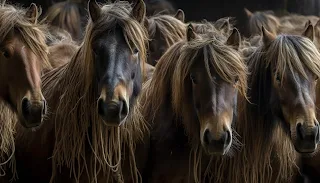How Horses Went From Wild to Mild: A History of Equine Domestication
Ever wonder how horses went from roaming wild and free to becoming our faithful companions and partners? Their journey to domestication is a fascinating one that spans thousands of years.You might think that early humans simply captured some wild horses and tamed them, but the story is far more complex.The relationship between horses and humans goes back nearly 10,000 years to the Eurasian steppes, where hunter-gatherers first began interacting with wild horses. Over time, as humans transitioned to agricultural societies, our connection with horses grew closer.We began to see the potential benefits of domesticating horses, and around 3500 BC, the first truly domesticated horses emerged. Since then, horses have been our allies in work, war, sport, and companionship. Their story is one of an evolving partnership that has shaped the destinies of both species in profound ways.How did the horse's transition from wild equine to humankind's most versatile domestic animal come about? Read on to discover the fascinating history of how horses went from wild to mild.
When and Where Were Horses First Domesticated?
Horses were first domesticated around 6,000 years ago, though some estimates push that date back to possibly 10,000 years. The earliest known domesticated horses were found in the Eurasian Steppes, in what today includes Ukraine, western Russia, and Kazakhstan.
The horse was initially domesticated as a source of meat and milk. People began selectively breeding horses for specific traits like size, coat color, and temperament. Over centuries of breeding, the physical characteristics and behaviors of horses adapted to suit human needs and uses.
Riding horses didn't become common until around 3,000 years ago, starting with chariots and eventually progressing to individuals riding horses. The domesticated horse allowed for faster travel, expanded trade routes, and new developments in warfare.
The domesticated horse spread from central Asia to Egypt and the Middle East, then throughout Europe and east to China. Different breeds emerged in isolated areas, shaped by the environment and human purposes. The Arabian horse, for example, was bred for its speed, endurance, and companionship. Draft horses, like the Clydesdale, were bred to be powerful workhorses for farming and industry.
Today, there are over 300 horse breeds, descended from those first domesticated Eurasian wild horses. While a small number of truly wild horses still remain, most "wild" horses today are actually feral descendants of escaped or abandoned domesticated horses. The horse has been by our side as a faithful companion and helper for thousands of years - a partnership that has endured and spread around the globe.
What Led to the Domestication of Horses?
Why were horses first domesticated? It came down to a combination of factors, including environment, human need, and opportunity.
Around 6,000 years ago, the climate in Central Asia began to change. Grasslands emerged, providing plenty of food for large herd animals like horses. At the same time, the earliest pastoral nomads started migrating into the region. They were in need of animals they could herd, hunt, and use for milk, meat, hides, and transportation.
The wild horses that inhabited the Eurasian steppes were ideal candidates for domestication. They lived in large social groups, making them easier to capture and tame. Unlike wild asses or onagers, ancient horses were also physically suited to carrying humans and cargo.
As nomads started hunting wild horses, they likely captured some foals and raised them. Over generations, these early pastoralists developed close relationships with the horses. They bred the tamer and more cooperative animals, eventually producing the first domesticated horses.
Horse domestication revolutionized human civilization. With the help of these four-legged companions, nomads gained mobility and a vital food source. They could travel greater distances, hunt more efficiently, and trade with distant peoples. The earliest horse riders also gained a military advantage over opponents fighting on foot.
It's fascinating how the interplay between environment, human need, and animal behavior led to the domestication of horses. Our equine friends have accompanied us for thousands of years, helping shape the course of human history. We owe a lot to those ancient Central Asian nomads who first looked at wild horses and saw possibility.
How Were Horses Initially Used After Domestication?
After horses were initially domesticated, they became invaluable to humans for transportation, farming, and warfare.
Transportation
Horses provided a fast and efficient means of transportation for people and goods. Once horses were bred to be strong and controllable, people could travel greater distances in less time. Horses and horse-drawn carts and carriages enabled the movement of crops, supplies, and products between locations. This allowed for greater trade and connectivity between communities.
Agriculture
Horses were crucial for agriculture and helped transform farming. They were used to pull plows, enabling farmers to till more land at a faster rate. This increased crop yields and food production, which could support larger populations. Horses also pulled carts to transport crops, manure, and other agricultural necessities. Their strength and endurance made difficult farm labor much more efficient.
Warfare
Horses gave military forces a strategic advantage in warfare. Cavalry forces, soldiers mounted on horseback, allowed for fast attacks, pursuits, and flanking maneuvers. Horses could charge at infantry forces, using their speed and mass to overrun foot soldiers. They also provided mobility for soldiers to get into optimal positions on the battlefield. The introduction of horses, along with new weapons and tactics, revolutionized warfare in many parts of the world.
In summary, after their initial domestication, horses became vital assistants to humans. They were crucial for transportation, agriculture, and warfare— helping communities become more mobile, food supplies more abundant, and military forces more formidable. The domestication of the horse was a pivotal moment in history that provided a catalyst for change across societies.
The Spread of Horse Domestication Across Eurasia
Horse domestication spread from the Eurasian steppes into new lands, introducing equines to different cultures and environments. As horses dispersed from central Asia, distinct breeds emerged that were well-suited to their new homes.
The Spread West
The earliest domesticated horses traveled west into Europe with nomadic tribes. As the tribes settled in different areas, their horses adapted to the local climate and terrain. Stocky, sturdy breeds emerged in northern areas, like the ancestors of Fjord horses in Scandinavia and Shetland ponies in Scotland. Lighter, swifter steeds developed in the central steppes, eventually becoming breeds like Lipizzaners, Andalusians, and Lusitanos.
The Spread East
Horses also journeyed east with nomadic tribes into China and beyond. Initially, horses were prized in China mainly for their military uses, like pulling chariots. Over time, as horses became more common, distinct Chinese breeds appeared, such as the Mongolian horse. The Mongolian breed is particularly hardy, able to survive frigid winters and travel long distances. Its endurance made it an invaluable asset during the rise of the Mongol Empire.
The Spread South
As horses migrated into the Middle East, North Africa, and India, they were bred with local equines, producing new varieties well-suited to hot, arid climates. Breeds like the Arabian, Akhal-Teke, and Marwari developed in these regions. With their stamina, agility and speed, desert breeds were prized for riding and light war chariots. Their bloodlines influenced many other breeds around the world.
The spread of domesticated horses across Eurasia demonstrates how human migration and culture can shape animal evolution. By breeding horses for different purposes in new environments, our ancestors developed a diversity of breeds that continue to enrich equestrian life today in so many lands. The enduring partnership between humans and horses has truly stood the test of time—and distance.
The Evolution of Horses Alongside Human Civilization
Horses and humans have lived together for over 6,000 years. Our relationship with these magnificent animals has profoundly shaped the development of civilization.
Domestication
The earliest known domesticated horses appeared around 3500 BC in the Eurasian Steppes. As humans transitioned from hunter-gatherers to farmers and pastoralists, horses became integral to transporting people and goods, as well as aiding in agricultural work.
Selective breeding of horses with desirable traits, like strength, speed, and tameness, produced animals well-suited to human needs. Over generations, domesticated horses evolved to be shorter, stockier, and less flighty than their wild counterparts. Different breeds emerged that were tailored to specific purposes, such as light riding (Arabian), heavy farm work (Draft), or racing (Thoroughbred).
Advancing Society
The spread of domesticated horses had a revolutionary impact on trade, transportation, and warfare. New kingdoms and empires rose on the backs of horses, most notably the Mongol Empire which at its peak stretched across much of Eurasia. The increased mobility provided by horses allowed for greater cross-cultural connections between distant peoples.
The evolution of horseback riding and the invention of the chariot, wagon, and eventually the stirrup gave humans a means of efficient long-distance transport as well as a formidable advantage on the battlefield. The domesticated horse truly helped drive the advancement of human civilization.
Today, horses remain an important part of human society. While their role has diminished in transportation and agriculture, horses are still valued companions in sport, recreation, and therapy. The enduring partnership between horses and humans is a testament to the close bond we share with these noble allies. Our history has been inextricably linked for millennia, and horses will likely continue to stand by our side into the future.
Conclusion
So there you have it, how horses went from wild to mild. From their early ancestors roaming the grasslands of Eurasia to becoming an integral part of human society, the horse has had quite the journey. While the details of equine domestication are still debated, it’s clear that horses and humans have developed an unbreakable bond over thousands of years. Next time you see a horse, whether in a pasture or carrying a rider, take a moment to appreciate how far they’ve come to get there. Though they were once fierce and untamable, horses are now mild-mannered companions that have shaped the course of human civilization. Our history is their history, and we owe much of our progress to these four-legged friends.




